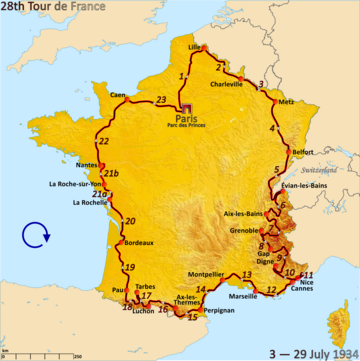 Route of the 1934 Tour de France followed clockwise, starting in Paris | |||||||||||||||||||||||||
| Race details | |||||||||||||||||||||||||
|---|---|---|---|---|---|---|---|---|---|---|---|---|---|---|---|---|---|---|---|---|---|---|---|---|---|
| Dates | 3–29 July 1934 | ||||||||||||||||||||||||
| Stages | 23, including one split stage | ||||||||||||||||||||||||
| Distance | 4,470 km (2,778 mi) | ||||||||||||||||||||||||
| Winning time | 147h 13' 58" | ||||||||||||||||||||||||
| Results | |||||||||||||||||||||||||
| |||||||||||||||||||||||||
The 1934 Tour de France was the 28th edition of the Tour de France, taking place from 3 to 29 July. It consisted of 23 stages over 4,470 km (2,778 mi). The race was won by Antonin Magne, who had previously won the 1931 Tour de France. The French team was dominant, holding the yellow jersey for the entire race and winning most of the stages. Every member of the French team won at least one stage.
French cyclist René Vietto rose to prominence by winning the mountains classification, but even more by giving up his own chances for the Tour victory by giving first his front wheel and later his bicycle to his team captain Magne.
The 1934 Tour de France saw the introduction of the split stage and the individual time trial. Stage 21 was split into two parts, and the second part was an individual time trial, the first one in the history of the Tour de France.